|
TennisOne Lessons Developing an Attacking Game: Learning to Close Doug King
Watching the Australian Open Patrick McEnroe, Mary Carillo, others often remarked on the importance of getting the feet set up for a shot in order to have good balance, focus, and control. This is sound advice and should be heeded. However, there are some exceptions to this rule, and the same announcers often made implicit references to them. There are instances when you may have the opportunity to set your feet for a shot but instead, the better option might be to hit the ball on the run. This occurs when we choose to run up to a ball that is “sitting up” (a softly hit floating ball) so that we can contact the ball on the fly as close to the net as possible and thereby increase our chances of either hitting a winner or applying serious pressure on our opponent. This is the basis behind the “attack” part of what we refer to as an “all court attacking game.” In this article we will look specifically at how to attack the sitter and, in general, how to become more effective at finishing points off at the net. Closing on the Net The general idea of moving forward in the court and volleying the ball is to take the offensive and increase the chances of hitting a winner. Of course by moving forward you both increase the potential angle of your shot and reduce the amount of time that your opponent has to react to it. Your ability to intercept a volley as close to the net as possible plays a vital role in your net game. This is called “closing on the net.”
Closing on the net is the ultimate goal of every net approach, whether it is a serve and volley, an attack off a short ball, a chip and charge off a return of serve, or even a “sneak attack” from the baseline, and it very frequently involves hitting the ball on the forward run. Risk and Reward There is always some risk involved in running forward and hitting a shot. As you run forward you are less stable and so focus is impaired. In addition, timing is more complicated because you have to time both your run and your swing to the oncoming ball, therefore you have less time to react. Imagine trying to hit a baseball by running forward at the pitcher - not so easy. But there are also rewards involved, namely, you get to hit the ball closer to the net. To be successful you must be able to do a couple of things - one is to learn stroke and footwork techniques that will minimize the risk, and two, you must learn to evaluate the situation and know when to employ the strategy. Let’s look at these skills and techniques. The First Step: Getting the Jump
Closing on the net is demanding on your footwork. You must be able to make quick bursts of speed, changes of direction, and use a variety of lateral and up and back footwork patterns. An explosive first step is critical to getting into proper position for your volley. This first step explosion after you execute the split step is necessary and it should be done the inistant you detect the ball is there for the picking. Of course one is looking for the sitter on the obvious attack situations – the serve and volley or the attack off of a short ball – but it can also occur at anytime during an exchange when one player is forced into a weak shot. Making this explosive first step starts with a good split step which will put you on the balls of the feet and create a springing action for propulsion. You must be able to execute the split step in sync with your opponent’s return so that you can neutralize your movement just a moment before your opponent contacts the ball and then react to the shot with a minimal loss of momentum. It is very similar to changing gears in a car; the split step puts you into the neutral gear and then, like a race car driver, you must be able to shift into gear and accelerate to the ball the moment you see what direction you need to go. All of this requires strength, agility, reflexes, timing, and technique (of course an asset in any part of footwork). Like anything the more you practice it the better at it you will become. This is why playing doubles or practicing your serve and volley will help you to develop the proper footwork for any attacking opportunity. Attack with Your Feet Successfully closing off the net requires not only good reactions but also commitment. You must attack the ball with your feet, quickly and decidedly. Once you make the determination that you are going to charge a sitter you must act immediately as any hesitation will often result in a lost opportunity and could easily reverse your fortune. Getting as close to the net as possible while maintaining proper racquet control requires very quick, small and precise steps. It is important to keep the strides even as you move through your shot and “follow through with your footwork” using a continuous stride, much like you would follow through on your swing with a continuous stroke movement.
Many players make the mistake of attacking the soft ball with the hands (by swinging aggressively) rather than with the feet (by running aggressively). This can result in costly errors, and can do serious damage to both your point total and your ego. An excellent drill to develop good closing footwork is what I like to call the Run with the Volley Drill. This drill is executed close to the net but the same footwork technique can be applied to balls taken in the mid-court area as well. The goal is to develop a feeling of not just running through the volley but also being able to feel as though you are actually running “with the volley.” Many players make the mistake of getting too anxious on the sitter. They reach or lean forward too early or they put too much emphasis on the contact itself. Use a proper combination of pace and placement for optimum results. Swing Techniques Of course, when we attack the sitter shot on the run we will use a more conservative stroke. But the length of the stroke will vary depending upon where you are on the court and how much pace is required to achieve the desired result. Remember, if you are coming up to the net it is important to put your opponent under pressure so you don’t want to just bunt the ball back too safely.
If you get a very slow, high ball you may have to use a relatively long stroke - sometimes resembling a groundstroke more than a volley. Although this is riskier, if the ball you are taking is high and slow, this may be what is required. Even if you are charging forward and taking it in the air, a high floating shot from your opponent will keep you further back in the court and will require you to use a bigger stroke to generate the required pace and depth to apply pressure. Also, if your opponent’s shot is slower then he will probably have more time to recover into position so you may have a smaller opening to hit into. Both conditions will demand that you stroke the volley with more authority. Typically the bigger swing will also be played with less underspin - often flat and in some cases with topspin. In today’s professional play we see pros using a very aggressive, relatively big swinging topspin drive volley on the mid-court sitter. This topspin drive volley has the advantage of pulling the ball down into the court while still maintaining a high degree of ball speed. This also allows the player to hit more angle on the shot while generating pace. This full swinging topspin volley can be very intimidating to an opponent and energizing to the striker but it can also be an unnecessary risk. On the other hand, being too conservative can also have disastrous consequences. Letting your opponent escape almost certain peril can result in an invigorating boost to his overall game. How often you use a topspin drive volley really comes down to how good you are at it. Players like Sharapova, Williams, and Federer are quite adept at this shot and use it effectively. Regardless of how conservative you try to be with your stroke there are always going to be errors, but letting your opponent track down a ball that you really should put away is also an error (although it may not show up in the statistics).
If you are very comfortable putting topspin on your groundstrokes then you should be able to use a similar stroke on the mid-court sitter. Just be careful not to do it when you are on a hard forward run. It is very difficult to manage a full swing under those circumstances. Whenever you use a big swing it tends to slow down the feet, both to prepare and to execute the action. By using a more conservative stroking action you will be able to move more quickly and deftly to the ball. If you have to charge forward further and faster always use a more conservative stroke action as this will allow you to go faster with better control. If you are moving more slowly through the ball (such as a mid-court semi-lob from your opponent) then a larger stroke is more reasonable. It is also important to avoid using topspin as a frequent practice on your volleys. Volleys are predominantly underspin strokes and the topspin drive volley should be reserved for the rare exception rather than the rule. Typically, you have better control of the depth of your shot with underspin and this is critical in putting away many volleys. You can also disguise the shot more easily with underspin, opting for a drop volley without showing it, and you can change your direction more easily and thus make your opponent commit to a move before you hit. All of these reasons make the underspin a better option for your basic volley technique. In the video below left, Pierce shows the inherent liability of a topspin volley. Instead of quickly moving her feet she gets slowed down preparing a bigger swing. She closes too slowly and lets the ball drop. She doesn’t disguise the shot (necessary to “hold” the opponent in position) nor does she give herself any chance to make any adjustments as she goes into the shot. The result is she lets her opponent stay in the point. A more technical volleyer would have used better footwork and focused more on getting to the ball as quickly as possible rather than wasting valuable moments preparing for a bigger stroke. By comparision notice how in the adjoining video Nadia Petrova puts more emphasis on aggressively getting her feet in: McEnroe, Rafter, Henman, and others rarely used a full swinging topspin stroke at the net. By comparison, Sampras shows much better footwork and volleying technique on the clip below right. With a lower ball and while on the full run, he uses a more traditional volley technique, short and with underspin to achieve more control over the placement of the shot. His focus is on his footwork rather than trying to produce a powerful swing, and he relies on positioning, deception, and placement to score the winner.
Another option is to use underspin on the volley. This should be done when the ball falls below the height of the net and you are forced to take some speed off of the ball. In this case placement, disquise and timing are required and learning to hold your opponent or hit behind them is key. Some players will even try the drop volley when the ball gets below the level of the net but this is extremely difficult when you are on a quick forward run.
Placement Another aspect of dealing with the sitter is where to place your shot. You must be careful to understand the relationship between depth and angle and your position on court. When you are in the mid-court area you have less angle available so you should not go for too much angle - especially on the higher, softer ball even though it is a great temptation to do so. Often the sharply angled ball off of the high mid-court volley will allow your opponent to run down your shot and hit a spectacular winner from way off the court. Even though your opponent looks like a magician you really are to blame for giving them the unnecessary opportunity. If you do try an angle from mid-court it is better to do it off of a low ball, one you can play very gently (almost like a drop shot). The important thing is to make sure your angled shot does not sit up and it is very hard to angle a high, mid-court ball and not have it sit up. When your shot sits up it allows your opponent to run it down. A good combination of angle and depth is the right shot for the putaway, with the emphasis on depth. I suggest to my students that when they take the floating mid-court volley they imagine a net on the opposite service line that they must hit over. This will help you get the proper depth and will ensure better results. You can add angle to the shot to play away from the opponent but remember that good depth is essential. Some players use topspin on this mid-court shot (as mentioned in the above section) and this will allow you to increase the angle, but, as I mentioned before, this technique is not for everybody. When you get very close to the net (half way up in the service box and closer), then you are in good position to really angle the ball. Remember to play soft on the low balls whereas you can add more pace to your angled shots on the high, close sitters. Pros will often bounce the sitters on top of the net hard towards the back fence rather than fooling around with a cute angle. It is on the balls that get below the level of the net when you need to become creative as power is not an option. Also realize that the more you are positioned in the middle of the court - even if you are right on top of the net - the less angle you have. When you are pulled to one side of the court and you are on top of the net is the best time to hit a firm angled shot. Anticipation
Another key to good closing at the net is “anticipation.” A good net player knows when to expect the opportunity to attack. This involves both keying on your opponent and also sensing the penetration of your own shot. The more pressure you put on your opponent the easier it is to anticipate his return since you have reduced your opponent’s options. Simply put, the better the shot that you hit the more you should expect a weak return and the more you should be anticipating the opportunity to rush forward to put away a sitter at the net. You must always maintain awareness of your opponent’s position on the court. Anytime your opponent is pulled out of position they become more vulnerable. When you see this, you should have your antennae tuned into the attack mode and begin moving forward. An opponent can be pulled out wide, pushed back deep, or even pulled up forward - all of these can be positions on the court where they are vulnerable. At the Australian Open Tsonga rushed forward after penetrating forehand drives when he felt Nadal was too deep in the court. He was then able to hit numerous drop volley winners (easy to say - much harder to do). And against Tsonga, Djovovic would do the opposite, pulling Tsonga forward with a good drop shot and then rushing forward to volley the sitter reply into an open court. In both cases the player was able to sense a situation of vulnerability in his opponent; both in terms of his opponent’s court position and his limited shot options, and rushed forward to take advantage of it. Another thing that you should learn to be aware of is your opponents' tendencies. Observe when it is they play softer, attackable balls. Look for cues in their grips, stances, and general preparation that would indicate a soft floating shot might be in the offering. When your opponent gets stretched and switches to a Continental grip, for example, that is a frequent indication that he will be playing an underspin shot and this increases your chances of getting an attackable sitter.
Or perhaps your opponent likes to play looping balls with exaggerated topspin. Notice what shots you hit to him that causes him to float up a weaker response. Perhaps he has trouble with low, underspin balls to the backhand side. If so, when you give him that shot be ready to move forward. Also be aware of when your opponent seems a bit lackadasical and loses focus, or gets fatigued physically or mentally. These situations will be times when you should expect to see more opportunities to charge the net. The Sneak Attack Successfully approaching and closing the net requires more than pure speed and aggression. In some instances it also involves stealth and deception. When you come to the net behind either a short ball or a serve, you are fully committing to the attack. In these cases you must attack aggressively with the intent of establishing strong position at the net (middle of the service box typically) by the time the ball is struck by your opponent. On the other hand you may be hitting a ball from a more defensive area of the court but still create an offensive opportunity. In this case, you may decide to shift forward in anticipation of a deep, floating return from the opponent and then break to the ball aggressively once you see your opponent’s shot. Rushing forward prematurely may alert your opponent to your attack and allow him to change the depth or speed of his shot to something more difficult to handle. The strategy resembles a delayed “sneak attack” And can catch your opponent by surprise. In the clips above we can see Davydenko show both types of closing attacks. In the first clip he takes a short ball and aggressively takes the net to finish with the volley, moving forward the entire time. In the second clip, even though he is deep in the court, he senses he has created an attacking opportunity and moves up but with more caution. Based on the strength of his shot and his opponent’s position he anticipates the weak return and once he sees the ball direction and trajectory, he attacks it as quickly as possible (notice the same technique in the clip of Sampras above). The timing and technique of these attacks is slightly different. In the first case he sprints forward prior to his opponent’s shot and in the second case he sprints forward after his opponent’s shot. In both cases he is closing into the net and hitting the ball on the run. Developing an Attacking Attitude
Key to becoming a good closer is developing the proper mindset. It's knowing when to attack and developing an “attacking attitude.” Great net players like John McEnroe, Pat Rafter, Tim Henman, and Martina Navratilova constantly maneuvered theor opponents to create an attaking opportunity, and when it arose they recognized it even before it happened and they acted on it without hesitation. Even Jimmy Connors, who was not a great technical volleyer, was one of the best closers ever. That was because he was always ready to attack and did it with such conviction and immediacy that he was very successful with it. Another thing they had in common was that they all attacked with quick, aggressive, and disciplined footwork rather than with anxious swinging. Like anything else an attacking style requires constant practice to learn and maintain the skills necessary to be a good closer. Attacking the sitter and becoming a better finisher is dependent upon a sense that borders on intuition and nerve. Its greatest enemy is fear, doubt, and hesitation. Don’t fret over mistakes - they are unavoidable. You’re not going to win every point even if you are doing the right thing. So don’t hesitate; learning to run through these shots will help you to put the final finishes on your all-court game. Your comments are welcome. Let us know what you think about Doug King's article by emailing us here at TennisOne.
Doug is one of the country's foremost tennis teaching innovators. Founder of Acceleration Tennis, a revolutionary teaching system, King is leading the way in reinterpreting the traditional tennis model. Doug King is currently Director of Tennis at Meadowood Napa Valley ( www.meadowood.com ), a Relaix Chateau Resort in St. Helena , CA . For more information on Acceleration Tennis please email Doug King at dking@meadowood.com. |

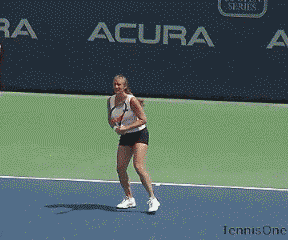
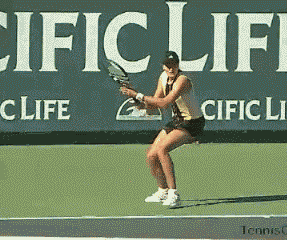
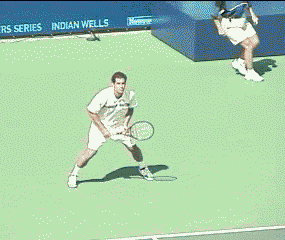
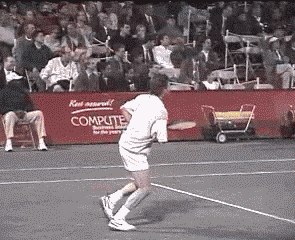
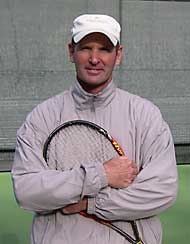
 Doug King studied with legendary tennis coach Tom Stow and was a
former California State Men's Singles Champion
and the former number one men's player of Northern California.
Doug King studied with legendary tennis coach Tom Stow and was a
former California State Men's Singles Champion
and the former number one men's player of Northern California.